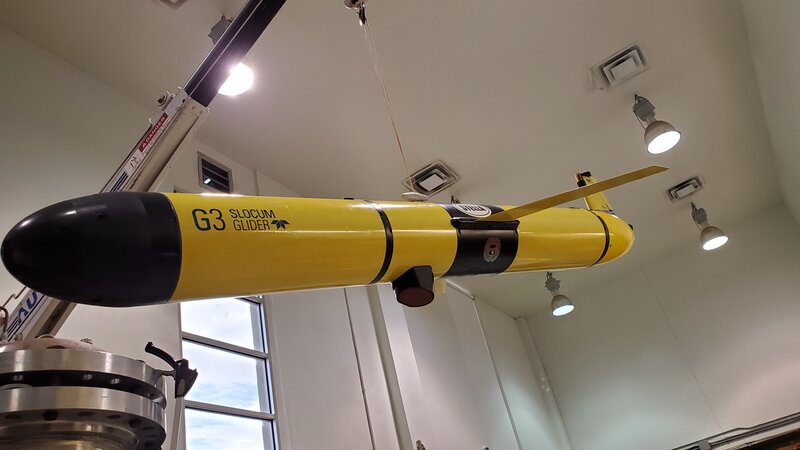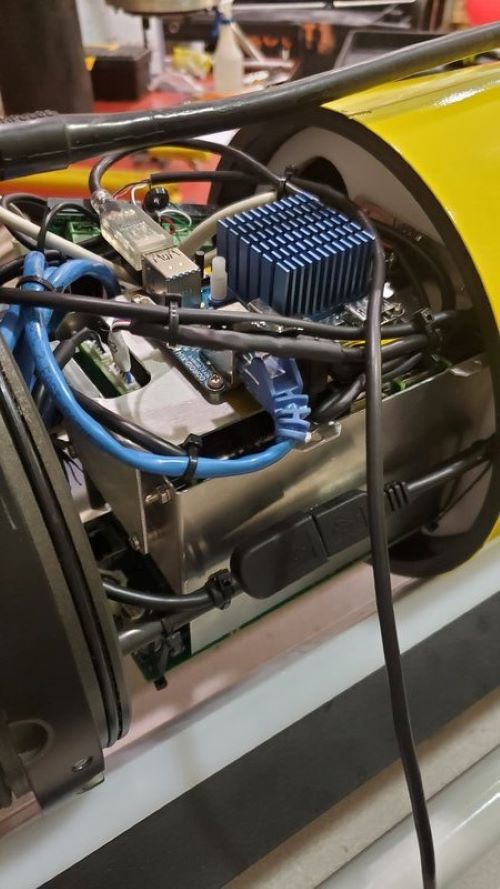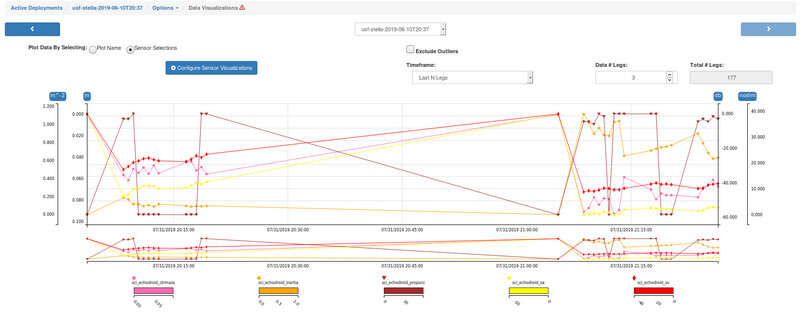
By John Horne, University of Washington
and Chad Lembke, University of South Florida
The increased use of ocean robots, such as autonomous underwater vehicles (AUVs), is expanding the resolution, range, and duration of physical and biological measurements collected throughout the water column in the world’s ocean. Remote sensing instrument packages installed within AUVs measure physical, chemical, and biological water properties as they sample from the surface to near the ocean floor or to their depth limitation. Biological measurements typically consist of plant pigment concentrations that are used as an index of microscopic phytoplankton abundance. But what about distribution and density measurements of larger animals such as shrimp, squid, and fish that are found deep in the water column, form distinct layers, and migrate hundreds of meters to shallow water every night?

Figure 1. The Teledyne Webb Slocum glider, nicknamed “Stella,” houses the acoustic echosounder and the acoustic brain, which allows for onboard data processing to produce “Echometric” values (a suite of statistical metrics that characterize the distribution of biomass through the water column). Image courtesy of John Horne, University of Washington. Download largest version (jpg, 2.5 MB).
In a collaborative effort among NOAA (NOAA Ocean Exploration and National Centers for Coastal Ocean Science), universities (University of Washington, University of South Florida, Florida International University, and Nova Southeastern University), and industry (Teledyne Webb Research and Kongsberg Underwater Technology Inc.), a Slocum glider (Figure 1) was equipped with a Simrad WBT mini echosounder to measure macroscopic animals during the glider’s descents from the surface to bottom waters.

Figure 2. An Odroid XU4 computer mounted on top of the Kongsberg Simrad WBT mini echosounder. The computer receives data from the echosounder, computes “Echometric” values (a suite of statistical metrics that characterize the distribution of biomass through the water column), and sends them to the glider science computer for transmission to an iridium satellite when the glider surfaces. Image courtesy of John Horne, University of Washington. Download largest version (jpg, 2.5 MB).
Collecting active acoustic data from an underwater glider is not unique, but what is special about this technological development is the availability of data in “glider time.” Until now, echosounders on gliders stored data on internal memory cards that could only be retrieved and read once the vehicle had been recovered. No data was available while the glider was deployed because there was no way to send large data volumes to shore. Therefore collected measurements could not be used to alter the glider’s path to investigate something interesting. The addition of an “acoustic brain” solves the challenge of sending large data volumes through a limited satellite data channel. An additional small computer was integrated into the glider sensor package (Figure 2) to read acoustic data during each dive, compute a suite of statistical metrics called “Echometrics,” which characterize the distribution of biomass through the water column (Figure 3), and then transmit those metrics and a low-resolution echogram through the glider’s satellite connection to the pilots and scientists who deployed the glider. The use of Echometrics and low-resolution echograms to synthesize the acoustic data record solves the problem of limited bandwidth in satellite data transmissions as raw acoustic data are about 40 times larger than the Echometric values that are transmitted.

Figure 3. Screenshot of the glider mission control software showing individually colored plots of “Echometric” values through two dives. The x-axis represents time and the y-axes represent scales for each metric plotted. The echosounder collects data during dive descents, so values are shown until the end of one dive and then the plots jump to the start of the next dive. In the figure the first descent occurs during the first quarter of the graph. The second dive starts after the ascent and is located in the final quarter of the graph. Image courtesy of Chad Lembke, University of South Florida. Download largest version (jpg, 200 KB).
The availability of Echometric values and data snapshots provides pilots and scientists with additional information to be used to direct the glider during its deployment. A glider’s sampling plan or mission can be altered during a deployment to investigate features that are revealed by the data. Higher resolution measurements of animals, monitoring change in biological aggregations, predator-prey interactions, and investigating deep scattering layers as they migrate to the surface at night or back down to deep water before dawn are now possible with the addition of an echosounder, acoustic brain, and a lot of computer programming. The acoustic glider can now provide near real-time insight into distributions and dynamics of animals that inhabit mesopelagic waters of the ocean.
Published July 30, 2021